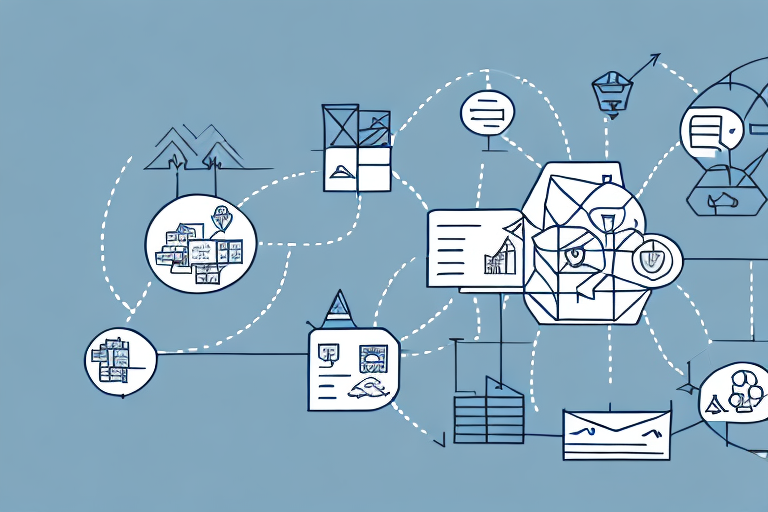How CBP is Streamlining Supply Chain Management
Supply chain management is a complex process involving numerous stakeholders, including manufacturers, exporters, importers, and government agencies. The US Customs and Border Protection (CBP) plays a vital role in ensuring the smooth flow of goods through US borders. To achieve maximum efficiency, CBP has implemented several measures to streamline the supply chain management process.
The Role of Technology in CBP's Supply Chain Management
CBP has heavily invested in technology to enhance the efficiency of its supply chain management. The agency utilizes a variety of software and hardware systems to facilitate the tracking and monitoring of goods. For instance, the Automated Commercial Environment (ACE) system enables importers and exporters to submit trade-related data electronically, eliminating the need for manual paperwork. Additionally, the use of radio frequency identification (RFID) technology at border crossings has enabled CBP to track and monitor goods in real-time, thereby reducing the time and cost involved in inspection and clearance.
In addition to the ACE system and RFID technology, CBP has implemented advanced analytics and data visualization tools to improve decision-making and risk management. These tools enable CBP to analyze large volumes of data from various sources, such as cargo manifests, trade agreements, and intelligence reports, to identify potential threats and anomalies in the supply chain. This data-driven approach allows CBP to allocate resources more effectively and efficiently, targeting high-risk shipments for inspection and screening.
CBP's Efforts to Improve Efficiency in the Supply Chain
CBP has developed several initiatives to facilitate the clearance of goods, including the Customs-Trade Partnership Against Terrorism (C-TPAT) and the Trusted Trader Program (TTP). These programs offer benefits such as expedited clearance, reduced inspections, and access to CBP's resources, such as the Automated Targeting System (ATS). Additionally, CBP has partnered with other government agencies and industry stakeholders to enhance the sharing of information and resources, reducing the risk of delays and errors in the supply chain.
One of CBP's newest initiatives is the Automated Commercial Environment (ACE), a web-based portal that streamlines the import and export process by allowing businesses to submit electronic documents and receive real-time updates on their shipment status. ACE also provides a centralized platform for CBP to share information with other government agencies, further reducing the risk of delays and errors in the supply chain. By leveraging technology and partnerships, CBP is committed to improving efficiency and security in the global supply chain.
The Importance of Collaboration in the Supply Chain
To optimize the supply chain process, CBP works closely with other industry stakeholders, including manufacturers, exporters, importers, and freight forwarders. CBP has established several partnerships with industry associations to facilitate joint training, sharing of information, and development of best practices. CBP also collaborates with foreign governments to facilitate cross-border trade and ease the clearance of goods. Through these partnerships, CBP ensures that supply chain stakeholders are informed and compliant with U.S. Customs regulations.
- Increased Efficiency: Collaboration helps identify areas where processes can be streamlined, leading to faster delivery times, reduced costs, and improved customer satisfaction.
- Risk Management: Sharing information allows stakeholders to identify potential risks and develop strategies to mitigate them, ensuring a more secure supply chain.
How CBP is Addressing Supply Chain Risks
CBP continuously monitors and assesses potential risks in the supply chain process. The agency has implemented several measures to mitigate these risks, including advanced screening tools and physical inspections. CBP collaborates with other government agencies, such as the Department of Homeland Security, to enhance its screening procedures and ensure the safety and security of goods. Additionally, CBP utilizes data analytics to identify and target high-risk shipments, reducing the likelihood of security breaches and other supply chain disruptions.
Furthermore, CBP has established partnerships with industry stakeholders to promote supply chain security. These partnerships involve sharing information and best practices to identify and address potential vulnerabilities in the supply chain. CBP also provides training and outreach programs to educate stakeholders on supply chain security and encourage their participation in securing the supply chain. By working together with industry partners, CBP strengthens the security of the supply chain and protects the American public from potential threats.
The Impact of CBP's Streamlining on Importers and Exporters
CBP's efforts to streamline the supply chain process have had a significant impact on importers and exporters. The implementation of ACE and other electronic systems has reduced the time and cost involved in trade-related paperwork, while the Trusted Trader Programs have facilitated expedited clearance and reduced inspections. Additionally, the enhanced collaboration between CBP and industry stakeholders has improved the overall efficiency of the supply chain, reducing the likelihood of delays and disputes.
Another significant impact of CBP's streamlining efforts is the increased transparency and visibility in the supply chain. With the implementation of electronic systems, importers and exporters can track their shipments in real-time, allowing for better planning and coordination. This has also led to improved security measures, as CBP can monitor and identify potential risks more effectively.
Furthermore, CBP's streamlining efforts have positively impacted small businesses. The Trusted Trader Programs and other initiatives have provided opportunities for small businesses to participate in global trade by reducing barriers to entry and providing support and resources. This has led to increased competitiveness and growth for these businesses, contributing to the overall economic development of the country.
Best Practices for Supply Chain Management
CBP recommends that industry stakeholders adopt best practices in supply chain management to optimize the process. These practices include:
- Proper Record-Keeping: Maintain accurate and up-to-date records of all transactions and shipments.
- Utilizing Electronic Systems: Implement electronic submission of documents to streamline processes and reduce errors.
- Due Diligence: Conduct thorough due diligence on suppliers and partners to ensure reliability and compliance.
- Regulatory Compliance: Stay informed and comply with relevant regulations to avoid penalties and delays.
CBP also recommends that stakeholders engage in continuous training and education to stay informed about changes in laws and regulations that may affect their supply chain operations.
Another important best practice is establishing clear communication channels with all stakeholders involved in the process, including suppliers, manufacturers, distributors, and customers. By maintaining open lines of communication, stakeholders can quickly address any issues that arise and work together to find solutions.
Additionally, regularly assessing and evaluating supply chain operations to identify areas for improvement is crucial. This can involve analyzing data on lead times, inventory levels, and transportation costs, among other factors. By continuously monitoring and optimizing their supply chain, stakeholders can improve efficiency, reduce costs, and enhance overall performance.
Case Studies: Successful Implementation of CBP's Streamlining Methods
CBP has several case studies showcasing the successful implementation of its supply chain streamlining methods. For instance, CBP worked with General Motors to streamline the clearance of automotive components, reducing the time and cost involved in the process. Additionally, CBP partnered with the Port of Long Beach to implement the TTP, resulting in a significant increase in the number of expedited shipments and a reduction in the time spent on inspections.
Another example of CBP's successful implementation of streamlining methods is its partnership with FedEx. CBP worked with FedEx to implement the Automated Commercial Environment (ACE) system, which allowed for faster and more efficient processing of shipments. As a result, FedEx was able to reduce its average clearance time from 45 minutes to just 15 minutes, leading to significant cost savings and improved customer satisfaction.
Future Developments in CBP's Supply Chain Management Strategy
CBP continues to explore new ways to enhance the efficiency of its supply chain management. The agency is investing in data analytics, artificial intelligence, and blockchain to optimize the tracking and monitoring of goods. Additionally, CBP plans to expand its Trusted Trader Programs and collaborate with more industry stakeholders to provide a seamless supply chain process. These developments are expected to increase the efficiency and cost-effectiveness of the supply chain process, benefiting all stakeholders involved.
Furthermore, CBP is looking into implementing more sustainable practices in its supply chain management strategy. The agency is exploring ways to reduce carbon emissions and minimize waste throughout the supply chain process. This includes partnering with suppliers who prioritize sustainability and implementing eco-friendly transportation methods. By prioritizing sustainability, CBP aims to not only improve the efficiency of its supply chain but also reduce its environmental impact.
Key Takeaways from CBP's Streamlining Efforts
The US Customs and Border Protection (CBP) plays a vital role in ensuring the smooth flow of goods through US borders. To achieve this, CBP has implemented several measures to streamline supply chain management. These measures include the use of technology, partnerships with industry stakeholders, collaboration with foreign governments, and enhanced risk assessment procedures. The benefits of these efforts are significant, reducing the time and cost involved in the clearance process while enhancing the overall efficiency of the supply chain. Best practices, continuous training and education, and new developments in data analytics and blockchain are expected to further optimize the supply chain process in the future.
One of the key technological advancements that CBP has implemented is the Automated Commercial Environment (ACE) system. This system allows for the electronic submission of trade data, reducing the need for paper-based processes and manual data entry. ACE also provides real-time visibility into the status of shipments, allowing for more efficient tracking and management of goods.
In addition to technology, CBP has established partnerships with industry stakeholders, such as importers, exporters, and logistics providers. These partnerships allow for greater collaboration and information sharing, enabling CBP to better understand and address supply chain challenges. CBP has also worked closely with foreign governments to establish mutual recognition programs, which recognize each other's supply chain security programs and facilitate trade between countries.




















